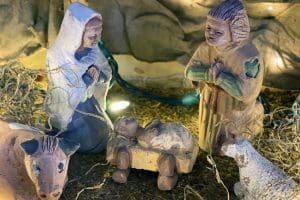![]()
The Dalai Lama
By Daniel C. Peterson and William J. Hamblin
The world’s last surviving god-king visited Utah a few years ago-His Holiness, the Dalai Lama of Tibet. Thousands of years ago, nearly all peoples of the world were ruled by kings claiming some type of unique relationship with the gods. From the pharaohs of Egypt to the lords of the Maya city-states, ancient rulers asserted that they were incarnate gods, sons of gods, descendants of the gods, or-at the very least-that they had some type of special relationship with the divine pantheon. Alexander was proclaimed son of Zeus by the oracle at Siwa oasis in Egypt; the Chinese emperor ruled as “son of Heaven” by the authority of a divine mandate; Hirohito, emperor of Japan, was forced to renounce his claims to divinity as part of the peace treaty of World War II.
Tibet was no different. A stark, forbidding region of the world whose lowest mountain valleys are 12,000 feet above sea level, Tibet was relatively isolated from outside influences and invasions for centuries. By the seventh century AD, however, Srong-bstan Sgam-po (pronounced Song-san Gam-po), united the fractious Tibetan mountain tribes and introduced Buddhism to Tibet by marrying Buddhist princesses from China and Nepal. In subsequent centuries, Buddhist ideas were synthesized with the indigenous Tibetan religion known as Bon, resulting in Tibetan Buddhism. Over the centuries, Buddhist monasticism became widespread, with an estimated 25% of the population of Tibet living in monasteries before the communist Chinese conquest in 1959.
In Tibetan (or Lamaistic) Buddhist thought, a buddha is one who has achieved supreme enlightenment, salvation, and release from the bonds of reincarnation. Theoretically, anyone can-and many already have-attained this form of salvation. Some special enlightened beings, known as bodhisattvas, have boundless compassion for mankind, leading them to take vows to voluntarily remain in this world through successive reincarnations in order to help others find the path to salvation. This belief in bodhisattvas was combined with a Tibetan Buddhist concept known as tulku, which holds that some great spiritual masters who have achieved enlightenment choose to be reincarnated again for the benefit of mankind. The Dalai Lamas are the supreme example of this compassion. They are not thought to be reincarnations of the founder of Buddhism, Siddhartha Gautama, but rather of the bodhisattva of compassion, Avalokiteshvara. (The current Dalai Lama, however, tends to downplay this tradition.)
The term Dalai Lama is a title, meaning “universal teacher,” which was used in the fifteenth century by the leader of the “Yellow Hat” monastic order of Tibet, a group that had been in fierce spiritual, economic and political competition with the rival “Red Hat” monks for centuries. In 1642, the fifth Dalai Lama, Nag-dban-rgya-mtsho, invited the Mongol Khan Gushri into Tibet; the Red Hat monks were defeated, and the Yellow Hat Dalai Lama was installed as supreme religious and political ruler of Tibet by the Mongols, who also follow Tibetan Buddhism. From then until 1959, the Dalai Lamas ruled Tibet as priests and kings.
The method of succession to this supreme office is quite remarkable. When the former Dalai Lama dies, his “soul,” the bodhisattva Avalokiteshvara, reincarnates itself in a Tibetan male child. Since this reincarnation can occur in literally any boy, the proper child is found by a combination of astrology, mysticism, and various tests wherein the child must recognize some of the royal paraphernalia of his former incarnation as the deceased Dalai Lama. Once selected, the new Dalai Lama is enthroned while still a small child and undergoes years of intensive training in Buddhist theory and practice.
The current (fourteenth) Dalai Lama, Tenzin Gyatso, was born in 1935. Recognized as the reincarnation of the former Dalai Lama at age three, he was enthroned at age five in 1940. Under increasing pressure from invading communist China, the Dalai Lama fled Tibet in 1959, and has remained in exile in India ever since. In the ensuing revolution, Tibet suffered horrendous massacres and wanton destruction of its great cultural heritage at the hands of the communists. A great teacher and writer, the Dalai Lama has been tireless in his efforts to preach Buddhism as well as to improve human rights and free his homeland from Chinese domination. In 1989 these efforts were rewarded with the Nobel Peace Prize.
There are a number of interesting books by and about the Dalai Lama:
Dalai Lama, The Art of Happiness: A Handbook for Living (Riverhead Books, 1998); ISBN: 1573221112.
Dalai Lama, Dalai Lama’s Book of Transformation (Thorsons Publishing, 2001); ISBN: 0007100973.
Dalai Lama, My Land and My People: The Original Autobiography of His Holiness the Dalai Lama of Tibet (Warner Books, 1997); ISBN: 0446674214.
Two movies portray the early life of the Dalai Lama: Jean-Jacques Annaud (director), Seven Years in Tibet (1997), and Martin Scorsese (director), Kundun (1997).
Useful introductions to Tibetan Buddhism include:
Robert A. F. Thurman, Essential Tibetan Buddhism (San Francisco: Harper San Francisco, 1996); ISBN: 0062510517.
Donald S. Lopez, Jr., ed., Religions of Tibet in Practice (Princeton: Princeton University Press, 1997); ISBN: 0691011834.

















